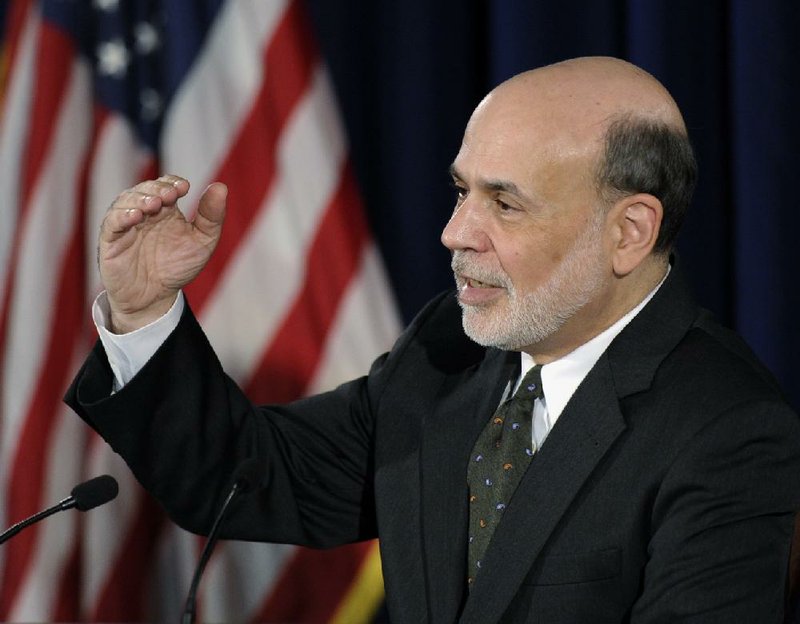WASHINGTON - The Federal Reserve will likely slow its bond-buying program later this year and end it next year if the economy continues to improve, Chairman Ben Bernanke said Wednesday, ending weeks of speculation about the Fed’s plans.
The Fed’s bond purchases have helped keep long-term interest rates at record lows. A pullback in the Fed’s purchases likely would lead to higher rates on mortgages and other consumer and business loans.
“The Fed is out of the closet,” said Ward McCarthy, chief financial economist at Jefferies Group in New York and a former Richmond Fed economist. “They expect to end these [bond] purchases. Bernanke wasn’t more specific than later this year, but connecting all the dots suggests he is thinking in the fourth quarter.”
Bernanke stressed that the Fed has “no deterministic or fixed plan” to end asset purchases.
“If you draw the conclusion that I just said that our policies - that our purchases will end in the middle of next year, you’ve drawn the wrong conclusion, because our purchases are tied to what happens in the economy,” he said. “If the economy does not improve along the lines that we expect, we will provide additional support.”
Bernanke said the reductions would occur in “measured steps” and that the purchases could end by the middle of next year. By then, he said he thought unemployment would be around 7 percent.
The chairman likened any reduction in the Fed’s $85 billion-a month in bond purchases to a driver letting up on a gas pedal rather than applying the brakes. He stressed that even after the Fed ends its bond purchases, it will continue to maintain its vast investment portfolio, which will help keep long-term rates down.
The ultra-low borrowing rates the Fed has engineered have been credited with helping fuel a housing comeback and spurred stocks to record highs that have restored the wealth America lost to the recession.
Anticipating higher rates, investors reacted Wednesday by selling stocks and bonds. The Dow Jones industrial average closed down 206 points. The yield on the 10-year Treasury note shot up to 2.33 percent from 2.21 percent.
“There’s fear you’ll see an expanding economy, which has a tendency to push up interest rates,” said Jack Ablin, chief investment officer of BMO Private Bank.
Some investors worry that higher rates will cause investors to shift money out of stocks and into higher-yielding bonds. Others fear that the economy might not be ready to absorb higher rates and that consumers and businesses could pull back on borrowing.
The Fed issued an updated economic forecast, which sketched a brighter outlook. It said the “downside risks to the outlook” had diminished since fall.
The more upbeat forecast helps explain why the Fed thinks record-low rates may soon no longer be necessary. Low rates help fuel economic growth. But they also raise the risk of high inflation and dangerous bubbles in assets such as stocks or real estate.
Speaking of the economy, Bernanke said, “The fundamentals look a little better to us.”
He spoke at a news conference after the Fed ended a two-day policy meeting. After the meeting, the Fed voted to continue the pace of its bond buying program for now.
Timothy Duy, a University of Oregon economist who tracks the Fed, called the statement “an open door for scaling back asset purchases as early as September.”
The fact that the Fed foresees less downside risk to the job market “gives them a reason to pull back” on its bond purchases, Duy said.
In its statement Wednesday, the Fed said it would maintain its plan to keep short-term rates at record lows at least until unemployment reaches 6.5 percent.
The Fed also released its latest economic projections Wednesday. Fed officials predicted that unemployment will fall a little faster this year, to 7.2 percent or 7.3 percent at the end of 2013 from 7.6 percent now. They think the rate will be between 6.5 percent and 6.8 percent by the end of 2014, better than its previous projection of 6.7 percent to 7 percent.
The Fed also said inflation was running below its 2 percent long-run objective, but noted that temporary factors were partly the reason. It said inflation could run as low as0.8 percent this year. But it predicts it will pick up next year to between 1.4 percent and 2 percent.
“The more upbeat tone and the change in the unemployment forecast will only encourage expectations for action soon,” Jim O’Sullivan, chief U.S. economist at High Frequency Economics, wrote in a research note. “We continue to believe that tapering could start at the Sept. 17-18 meeting.”
Investors may suspect the Fed is looking for a reason to scale back the bond purchases, said David Robin, co-head of the futures and options desk at the brokerage Newedge. “It’s a big mess,” he said.
The statement was approved on a 10-2 vote. James Bullard, the president of the Federal Reserve Bank of St. Louis, objected for the first time this year, saying he wanted a stronger commitment from the Fed to keep inflation from falling too low.
Esther George objected for the fourth time this year, again voicing concerns about inflation rising too quickly.
Information for this article was contributed by Martin Crutsinger, Paul Wiseman and Christopher S. Rugaber of The Associated Press and by Joshua Zumbrun and Jeff Kearns of Bloomberg News.
Business, Pages 27 on 06/20/2013

